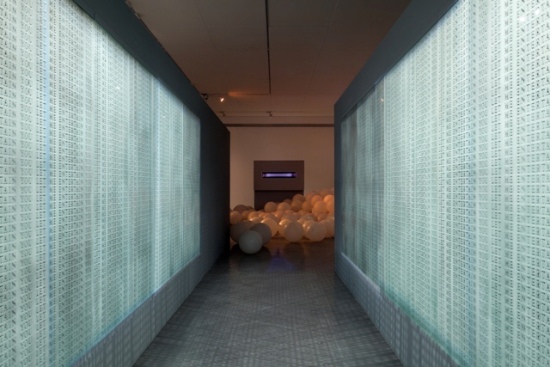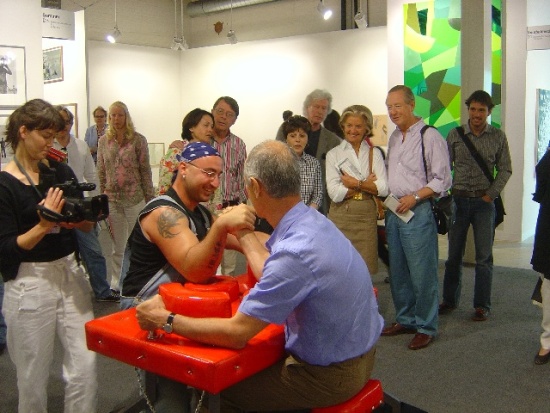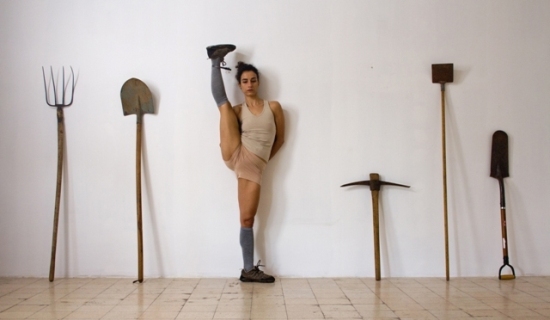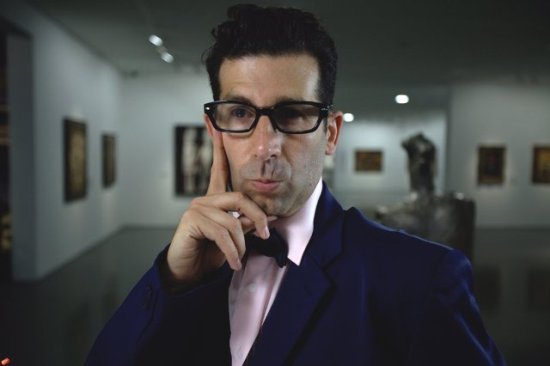Let me entertain you. Let me entertain you. This mantra is imprinted by Guy Zagursky onto a mirrored corridor at the heart of Curators and Co., recently opened at the Petach Tikva Museum. Unfortunately, after viewing this worthy but dull show whose umbrella theme is the relationship between artist and curator, this writer did not feel sufficiently entertained.
Two years ago, in preparation for this event, curator Revital Ben-Asher Peretz, invited nine of her colleagues to select an artist or group that would best represent their individual approach to curating. Meetings were held; and one definitely hopes that their deliberations were recorded, since the subjects on their agenda would surely suit a thesis or scholarly text. But now and here, when their ideas have finally crystallized into a joint art exhibition, the results, with a few outstanding exceptions, turn out to be self-reflexive and somewhat elitist in character.
![_622A~1[1]ellenginton](http://www.midnighteast.com/mag/wp-content/uploads/2011/09/622A11ellenginton.jpg)
This self-reflexive mood is especially noticeable in Picture Event, curated by Tel Aviv Museum senior curator Ellen Ginton. In true Postmodernist fashion she focuses on art processes, the lives of people making art, and the way that the public in general perceive art objects. To this end, she brought together two art-involved couples: herself and partner David Ginton; and Michal Goldman and David Reeb. The upshot was a very varied collection of paintings and photographs. Ginton paints and draws on the verso of paintings, in one case, creating a painting after a painting by French artist Ben Vautier. Goldman shows views of her studio, and creates portraits of her artist-friends, while David Reeb, alongside examples of recent work, displays photos of Israeli artists taken in museums throughout the world.
Low-key contributions come from Gideon Ofrat and Anat Gatenio who both elected to feature the work of dead artists. With The Cabinet of Emil Ranzenhofer, Ofrat, a curator universally esteemed for his pioneer work in researching Israeli art and its forgotten chapters, brings to our attention the lifework of a Zionist artist (1864-1930), once only second to E.M.Lilien in popularity. This exhibit is in the form of a mini-reconstruction of Ranzenhofer’s study based on a 1920s photo. Above the desk are faded replicas of the artist’s work, including a design for a Jewish National Fund certificate showing Zionist pioneers hoeing the land. Hung alongside are small reproductions of paintings by Ranzenhofer’s European contemporaries. Extra information is supplied by Ofrat’s recorded interview with Prof. Shaul Ladani who collects the artist’s work. Yet, despite Ofrat’s efforts which included locating and photographing a little street in Vienna named after Ranzenhofer, he does not succeed in making a strong enough case for the artistic rehabilitation of this artist.
Gatenio, a curator dealing with themes of memory, migration and loss, chose to mount an exhibition of paintings memorializing the artist Meir Franco, murdered in Sinai in 2002. She calls her project Remembering Curatorship, the reference being, so it seems, to memories of working with Franco in past exhibitions. But the truth is that Franco was a mediocre painter, and this display of his work is simply boring. For this reason, it is surprising that Gatenio did not choose to add greater impact by simultaneously showing the work of Franco’s partner Shosh Kormosh, an exceptionally gifted photographer, who died only months before him.

One wonders why the main feature in Shachar Kislev‘s interactive piece Primordial Soup is being shown in an Art Museum. Its natural home would be Jerusalem’s Science Museum where Amir Ben-Shalom, the instigator of this joint project, is the curator. It is in two parts. The first part of Kislev’s installation illustrates a well known scientific phenomenon. It consists of a glass tube which emits light when an electric current is passed through gas. The second, comprises a floor pool of soft balls which the visitor is invited to enter and touch. The text that accompanies this latter exhibit stretches the imagination beyond belief when it suggests that this ‘swamp’ of balls is an allegory for the crowded art world.

There are a number of exhibits that do reach out to the public and awaken interest. In this group, one returns first to Guy Zagursky, chosen to represent the curatorial approach of Tami Katz- Freiman whose past exhibitions have always been visitor friendly and visually captivating but carry deeper meanings. Zagursky’s second exhibit (located around the corner from his mirrored corridor), is Art Wrestling. This is a video documentation of a performance at Art Basel 2006 where members of the art world – curators, gallery owners, artists and critics were invited to hand-wrestle with him. All of them were overpowered, and he then cynically awarded himself the title ‘World Champion of Art.’ In this piece, the wrestling arena is apparently a metaphor for the inner circle of the art world and the power struggles involved to gain entrance.

“I Have Made up My Mind,” another appealing presentation, finds curator Tali Tamir working in tandem with the artist Hilla Ben Ari. This is a natural coupling, since both of them, here and in the past, relate to the subject of the individual vs. the group. (Ben Ari participated in Togetherness, The Group and the Kibbutz in Collective Israeli Consciousness curated by Tamir in 2005.)
Tamir makes a major contribution to Ben Ari’s new exhibit. Her voice is heard reading a text written at age 17 by her Polish-born grandmother, a counselor in Hashomer Hatzair youth movement. In it she expresses her emotional struggle to put ideology first, and subordinate self to the collective. The images that Ben Ari projects on two screens, a continuation of earlier projects, are metaphors for this conflict. For Dawn – in the light of day –a woman, limbs twisted unnaturally, become part of a line-up of agricultural implements; while for Dusk – when social pleasures beckon – Ben Ari’s video focuses on the trembling body of a gymnast striving to maintain a feat of balance.

While each of the nine projects on view is the outcome of sober deliberations, this description clearly doesn’t apply to The Curator, Shahar Marcus‘ hilarious video. Curated by the Museum’s Director Drorit Gur Arie, it is presented as an adjunct to this exhibition in Spot, the Museum’s new media center. Employing comic effects, short scenes and a narration of the type associated with lurid film trailers, Marcus pokes fun at the oh-so-serious profession of an art curator. The clip ends with a final announcement that The Curator is coming soon to a Museum near you. This is entertainment indeed.
Petach Tikva Museum, Yad Lebanim, 30 Arlozorov, Petach Tikva. Tel: 03-9286300






In response to Angela Levine’s review of Gideon Ofrat’s Cabinet of Emil Ranzenhofer contribution to the Curator & C. Exhibit at the Petach Tikva Museum of Art, I can only say that it is a disappointing that the Jewish Artist Emil Ranzenhofer continues to be under appreciated for the monumental contribution he made to the early Zionist Movement. In particular, for his design of the first four major JNF fundraising certificates: the Goldenbook Certificate, the Telegram, the Landspende (Land Donation) Certificate, and the Baumspende (Tree Fund) Certificate (see Die Welt, 23.6.1911; No. 25; pp. 589-590) Although his name appears clearly on all of these certificates prior to WWI, he is rarely, if ever, given credit for their design. These designs continued to be used by the JNF after WWI on post cards and gift receipt stamps. His Goldenbook Certificate is still being used today. Except for the telegram, Emil Ranzenhofer is rarely, if ever, acknowledged as the designer of any of these images! How can this gross oversight continue? Gideon Ofrat has made an attempt to right this wrong. Early JNF certificates and postcards (as well as correspondence about their commission) are difficult to locate, but may well be discovered in the Jerusalem JNF archives. It is hoped that exhibits of forgotten artists, like the Cabinet of Emil Ranzenhofer, may one day bring them them credit that they are due.
Comments are closed.